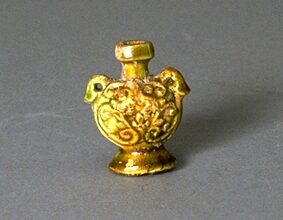Minature Pilgrim’s Flask
Chinese

Description
The Chinese fascination with imported luxury goods inspired potters to adopt new shapes and decorative motifs, especially those from Iran. One example is the so-called pilgrim flask, a flattened bottle used to carry water or wine. Perhaps originally made of stitched leather, the pilgrim flask shape was popular throughout Asia from at least the seventh century onward and can be found in a wide variety of sizes and materials. Compare this miniature pilgrim's flask with UMMA 1959/1.89.
Subject Matter:
A sancai (三彩), literally "three color," miniature pilgrim's flask of the Tang dynasty (618–907) with decoration influenced by Central Asian metalwork.
The Chinese fascination with imported luxury goods inspired potters to adopt new shapes and decorative motifs, especially those from Iran. One example is the so-called pilgrim flask, a flattened bottle used to carry water or wine. Perhaps originally made of stitched leather, the pilgrim flask shape was popular throughout Asia from at least the seventh century onward and can be found in a wide variety of sizes and materials.
During the stable and peaceful Tang Dynasty, the Silk Road brought exotic luxury goods to China, including metalwork, glass, precious stones, ivory, and textiles from Central Asian, India, and the Middle East. The bustling Tang capital of Chang’an (modern Xi’an) was a bit like the Paris and New York of today in its cosmopolitan mix of peoples, cultures, music, foods, and goods, especially from Central Asia.
Sancai was one of the most brilliant innovations of Tang dynasty potters. Working with the same clay used to produce white wares, potters added iron, copper, and cobalt oxide colorants to create the typical "three-color" palette of cream, amber, olive green and cobalt blue. Sancai ware can contain any combination of just two to all four colors. Cobalt oxide was a new import from Persia and was a key component in the development of the "three-colored" glaze palette. Lead flux made it possible for these colored glazes to fuse to the earthenware body at relatively low kiln temperatures. It also allowed glazes to run, which made them very difficult to control, yet aesthetically appealing.
Sancai, flourished from around 680 to 750 under the patronage of the Tang elite for the production of tomb figurines and mingqi, “bright vessels,” or funerary pottery. Since the Qin dynasty (221 - 206 BCE), ceramic figures have been used to replace human sacrifice in burial practices as mingqi (明器), literally "bright objects," or grave goods, as a way to provide for the deceased. A tomb could contain anywhere from a few, to several hundred ceramic mingqi items.
Physical Description:
A small earthenware flask with a flattened round body on a tall trumpeting footring. The flask has a tall neck with a wide articulated straight rim and two lug handles on opposing sides. Both sides of the body have a molded vine motif. The flask is covered in green, amber, and brown glazes, with traces of gold leaf.
Usage Rights:
If you are interested in using an image for a publication, please visit https://umma.umich.edu/request-image/ for more information and to fill out the online Image Rights and Reproductions Request Form.